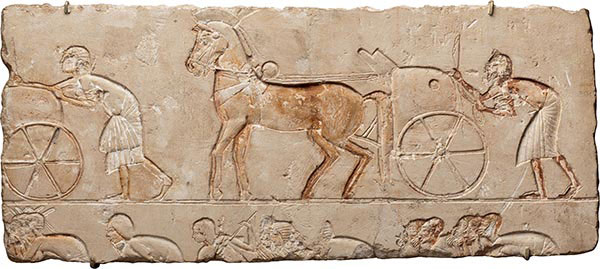The earliest known chariots appeared somewhere between 3000 - 4000 BC in Mesopotamia and they were constructed of wood with four solid wooden wheels. The chariot is the earliest known wheeled vehicle according to some experts. It is believed that oxen were used to propel these earliest chariots and that they moved slowly and had fixed axles. They had high dashboards and sidescreens protecting the riders, both spearmen and charioteers.
Some experts do not believe that fighting was conducted from the four-wheeled chariot. It is believed that neither axle could pivot.

Court ladies taking part in a royal procession stand in light chariots, as their drivers urge on the horses; Circa 1353-1336 B.C.
From Egypt; Probably from Middle Egypt, Hermopolis (Ashmunein; Khemenu);
Probably originally from Amarna (Akhetaten).
Medium: Limestone, paint.
Gift of Norbert Schimmel, 1985.
The Metropolitan Museum of Art, NYC.
Eventually, two-wheeled chariots appeared and they were lighter, more maneuverable and much faster than the four-wheeled type. Subsequently, much lighter spoke wheels appeared on the two-wheeled chariot and they were probably developed specifically for military purposes in what became another early case of military technology transfer. Teams of either two or four onagers, or asses, drew these chariots. The configuration of the draft team is thought to have been two abreast at this time.
By about 2000 BC, horses began to be used as draft animals for chariots and this was a dramatic innovation that increased the speed of the chariot substantially. The military use of horses soon brought forth attempts at animal husbandry and selective breeding. Horse-drawn chariots gave militaries incredible mobility. The advantage of chariots was that their speed enabled them to run circles around the phalanx, a sophisticated and effective infantry formation of the period. Charioteers used bows to launch arrows at the enemy's infantry while attempting to stay out of the range of enemy fire. As they circled about, they could tighten the circle about the enemy as they became worn down. Once the enemy was sufficiently softened up, chariots could be put into formation and a charge could then ride the enemy down. Although chariots were symbolic of military power by Bible times, they were expensive to operate, especially in terms of manpower. Each chariot required a crew of at least two or more men, only one of which would actually fight in battle.
Chariots changed battlefield tactics significantly and they were used in many parts of the ancient world. It is known that they were being mass-produced in Egypt by about 1435 BC. During this period, the wheels became a four-spoke design and the entire Egyptian chariot became much lighter and more sophisticated. Concurrently, chariots were in use throughout the Middle and Far East as well as Southern Europe and Crete.

Relief fragment with chariots,ca. 1352-1336 B.C.
This relief was discovered in the Sanctuary area of the Great Aten Temple at Amarna. In the upper register are chariots with their spirited horses held in check by grooms. Scenes of waiting chariots flanked depictions of the royal family inside the temple worshipping the Aten: the family had driven to the temple in their chariots, and left the restless horses to await their return after worshipping. The register below depicts various attendant groups also waiting outside the temple for the return of the royal family.
From Egypt, Middle Egypt, Amarna (Akhetaten), Great Temple of the Aten, Sanctuary, Egypt Exploration Society excavations, 1926-27.
Medium:Limestone, paint.
Gift of Egypt Exploration Society, through the generosity of Mrs. Fahnestock Campbell, 1927.
The Metropolitan Museum of Art, NYC.
The importance of chariots paled in deference to cavalry after this period. By the time of Alexander the Great, (335-323 BC) the cavalry had superseded chariots in importance, but the technology had transferred to the popular sport of chariot racing. The war chariot remained in use until about 400 AD in remote places while chariot racing continued to be popular in many places. Racing chariots became distinct from war chariots including their draft configurations. By the time that chariot racing faded in popularity, ponies running three or four-abreast were common draft configurations for racing chariots.